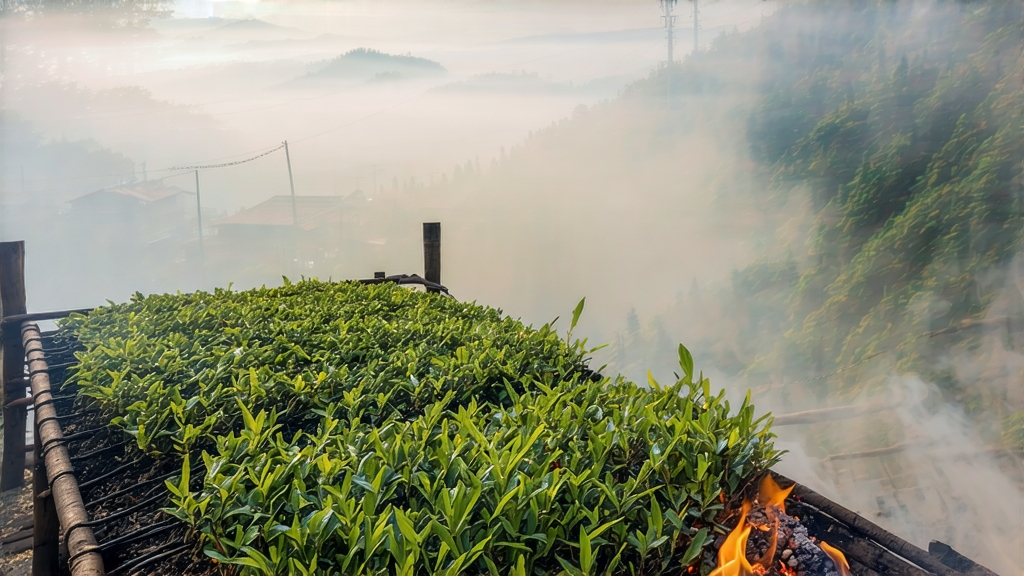
When European tea clippers first rounded the Cape of Good Hope in the late 1600s, the cargo that most excited London auctioneers was not silks or porcelains but small, glossy-leafed chests from the Wuyi Shan of northern Fujian. Marked “Bohea” (a corruption of the local place-name), these dark, twisted leaves released, once infused, a liquor the color of burgundy and an aroma that hinted of campfire and dried longan. That tea—today called Lapsang Souchong—was the world’s first intentionally produced black tea, and it would redefine how China, and later India and Sri Lanka, thought about oxidation, trade, and taste.
Historical records kept by the Dutch East India Company show that by 1604 “smoked bohea” already commanded twice the price of green tea at Amsterdam wharves. Local legend in Tongmu Village, the tiny Wuyi gorge where the tea is still made, tells a more colorful origin: Qing-era soldiers, quartered overnight in tea factories, delayed leaf processing so long that the green leaves turned crimson. Resourceful farmers, desperate to salvage the crop, dried the oxidized leaves over hastily built pine fires to meet next-day contracts. The Europeans loved the accidental flavor, and the farmers—ever pragmatic—repeated the “mistake” the following year. Thus was born what the Chinese call zhengshan xiaozhong—“small-leaf variety from the original mountain”—and what the West, via Cantonese traders, pronounced “Lapsang Souchong.”
Geographically, Tongmu is a granite ravine sealed by thick bamboo forest and perennial cloud. Daytime temperatures hover around 18 °C; humidity rarely drops below 85 %. These cool, misty conditions slow leaf growth, concentrating amino acids and sugars that later translate into malt sweetness capable of balancing assertive pine smoke. The gorge’s microclimate is so crucial that China’s 2002 national standard (GB/T 13738.3) restricts the name “Zhengshan Xiaozhong” to leaves picked within the 600–1 200 m contour of Tongmu and three neighboring villages. Anything produced outside this 535 km² core must be labeled “waishan” (outside-mountain) and typically lacks the subtle honeyed finish that justifies the original’s cult status.
The cultivar itself is a shrub-type Camellia sinensis var. sinensis known locally as cai cha, a mixed population of seed-propagated plants whose tiny, slightly serrated leaves resemble a sparrow’s tongue. Because the bushes are never irrigated or fertilized aggressively, leaf yield is low—roughly 350 kg of fresh leaves per mu (0.067 ha) versus 800 kg in modern clonal gardens—but the chemical profile is intense: polyphenol 32 %, water extract 46 %, and a l-theanine level above 2.2 %, rare for black tea. Picking standard is two leaves and a bud, but the most prized grade, called “jungle essence,” is harvested from wild-standing trees that have grown above 1 000 m for more than sixty years. These trees are reached only on foot, and plucking takes place between Qingming and Grain Rain, when spring mists are thickest and aphids have not yet appeared.
Processing begins within minutes of plucking. The leaves are first withered over ravine-side pine charcoal trenches. Instead of the gentle warm air used for modern black teas, craftsmen suspend bamboo trays 70 cm above glowing embers, allowing smoke to drift upward for 8–10 h. Temperature is kept below 30 °C so that enzymatic oxidation can proceed while leaves simultaneously absorb resinous volatiles such as alpha-pinene and longifolene. Every 30 min the witherer gently shakes the trays, ensuring even exposure; by dawn the leaves have lost 65 % moisture and turned matte gray-green.
Rolling follows, but unlike the high-pressure CTC (crush-tear-curl) method common in Assam, Tongmu artisans use a 23 cm diameter bamboo kneading-board. Pressure is applied in rhythmic pulses—fifty turns clockwise, twenty counter-clockwise—so cell walls crack without rupturing, preserving long, wiry strips. The rupture rate is held to 78 %, low enough to keep smoke from turning bitter during later firing.
Oxidation is conducted in giant fir-wood chests lined with wet